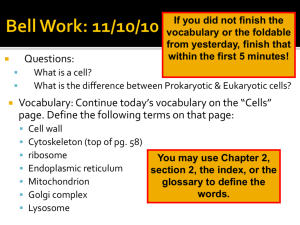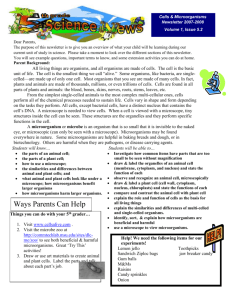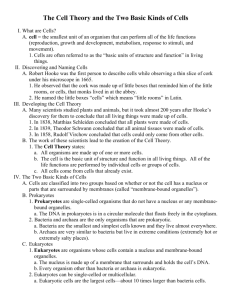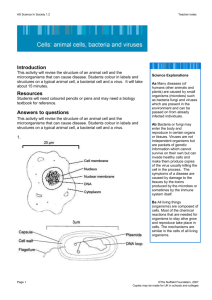Cells and Microorganisms Overview
advertisement
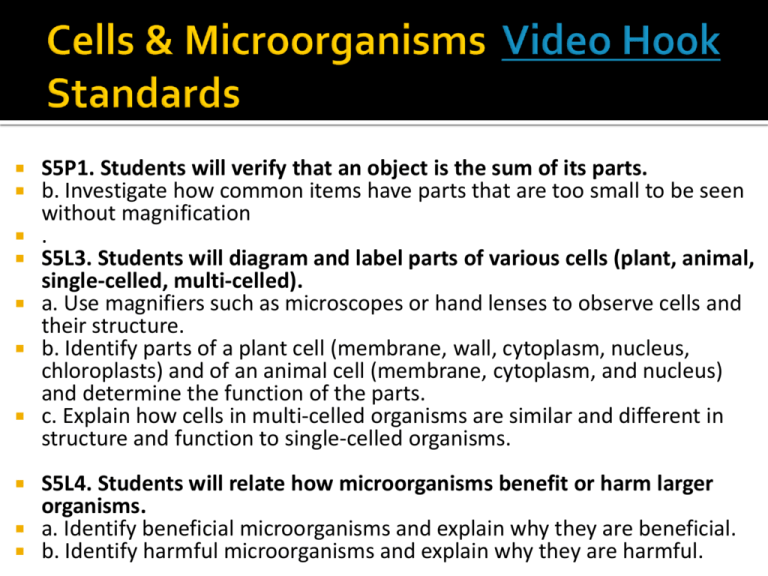
S5P1. Students will verify that an object is the sum of its parts. b. Investigate how common items have parts that are too small to be seen without magnification . S5L3. Students will diagram and label parts of various cells (plant, animal, single-celled, multi-celled). a. Use magnifiers such as microscopes or hand lenses to observe cells and their structure. b. Identify parts of a plant cell (membrane, wall, cytoplasm, nucleus, chloroplasts) and of an animal cell (membrane, cytoplasm, and nucleus) and determine the function of the parts. c. Explain how cells in multi-celled organisms are similar and different in structure and function to single-celled organisms. S5L4. Students will relate how microorganisms benefit or harm larger organisms. a. Identify beneficial microorganisms and explain why they are beneficial. b. Identify harmful microorganisms and explain why they are harmful. All living things are made of cells. The structures inside of cells have unique functions. Single-celled organisms can be both beneficial and harmful to humans. HSP Science page 234 A cell is the basic unit of structure and function in living things. Most cells are microscopic—they can be seen only with a microscope. HSP Science page 239 Single-Cell Organism Made up of only one cell. Bacteria are singlecelled organisms. Multi-cell organism Composed of several or many cells www.dictionary.com Cell Microorganism cell membrane, cell wall, cytoplasm, nucleus, chloroplasts structure function magnifying microscope single-celled multi-celled harmful disease protists germs microbe beneficial bacteria protozoa virus All living things are made up of cells. Each of us has about 100 trillion- an enormous number which is difficult to imagine. Each cell is a sort of bag made from a sort of skin called a membrane. The inside of a cell is watery and jelly-like. Cells are very small - you can't see them just using your eyes. You need to use a microscope, which makes them look many times bigger that they actually are. Many cells cannot be seen with the naked eye. Animal and plant cells are structured differently. Organisms can be single-celled or multi-celled. Some objects are too small to be seen without magnification. Microscopes make it possible to see that living things are made up mostly of cells. Some organisms’ cells vary greatly in appearance and perform very different roles in the organism. Some organisms are made of a collection of similar cells that benefit from cooperating. Bill Nye-Cells Intro to Cells Cell Video (Parents, cut this video at 6:20.) Cell Rap http://www.jonathanfeicht.com/cells.html Prokaryotic cell – No true nucleus Pro means “before ,” and Karyose means “kernel, "as in a kernel of grain. Early scientists referred to a cell nucleus as a karyose since it looked like a kernel in the cell. Prokaryotic therefore means “before a nucleus.” Eukaryotic cell –Has a true Nucleus Eu means “true" and karyose means “kernel”; eukaryotic therefore means "possessing a true nucleus. http://www.nisdtx.org/cms/lib/TX21000351/Centricity/Domain/249/prokaryotic-eukaryotic-student-pages-11nov8.pdf Nucleus – directs the cell’s activities (control center) Cytoplasm – a jelly-like substance that contains chemicals that help the cell stay healthy Cell membrane outer coating Holds the cell together Separates the cell from it’s surroundings http://studyjams.scholastic.com/studyjams/jams/science/animals/animal-cells.htm LIKE THE ANIMAL CELL Nucleus – directs the cell’s activities (control center) ONLY IN THE PLANT CELL thick outer layer Protects the cell Cytoplasm – Supports and gives structure a jelly-like substance that contains chemicals that help the cell stay healthy Cell membrane outer coating Holds the cell together Separates the cell from it’s Cell Wall- Chloroplast Makes food for the cell Gives plants the greenish color surroundings http://studyjams.scholastic.com/studyjams/jams/science/plants/plant-cells.htm Nucleus – directs the cell’s activities (control center) thick outer layer Protects the cell Cytoplasm – Supports and gives structure a jelly-like substance that contains chemicals that help the cell stay healthy Cell membrane outer coating Holds the cell together Separates the cell from it’s surroundings Cell Wall- Chloroplast Makes food for the cell Gives plants the greenish color LIKE THE ANIMAL CELL ONLY IN THE PLANT CELL Microorganisms can be beneficial. Microorganisms can be harmful. Microorganisms are too small to be seen with the naked eye. Microorganisms are living things. Microorganisms are not plants or animals. Organisms only contain cells, such as blood cells. Cells are too small and numerous to observe. Microorganisms are non-living. All microorganisms are harmful. Bacteria and viruses are the same. Different diseases are caused by the same germs. Organisms are mostly made up of cells that work together. Many cells such as onion skin cells and cheek cells can be viewed with magnification. A microorganism is a living single-celled organism of microscopic size. Some microorganisms are harmful, but some are beneficial. Decomposers are microorganisms. Many microorganisms are used in the food-making processes and aid in human digestion. Bacteria are the simplest living group of organisms and inhabit practically all environments. Viruses are generally regarded as non living and therefore are not microbes. Different diseases are caused by different microorganisms. There are four major types of germs: bacteria, viruses, fungi, and protozoa Bacteria grow best in a warm and moist environment. How to prevent getting sick? Wash hand with soap and warm water. Chlorophyll is found in Chloroplasts. The genetic material in a cell is found in the nucleus. Scientist change the nucleus to change organisms. Viruses cause sickness like HIV, AIDS, eboli Flatworm Paramecium Amoeba What is the role of decomposers in the food chain? VIDEO VIDEO Microorganisms are living things you cannot see without a microscope. Some are helpful while others are harmful. Bacteria live on and in our bodies and keep us alive! Bacteria are used to make cheese and yogurt! Different types of bacteria cause different tastes! Mold is a type of fungus. A mold called penicillin is an antibiotic (medicine) we take to kill bad bacteria. Bad bacteria Penicillin Yeast is another type of fungus. We use yeast when baking bread (releases CO2) and to make wine (creates ethanol). Some microorganisms make us very sick and destroy our food. Some types of bacteria are responsible for sicknesses such as pneumonia and food poisoning. Fungus can cause things such as: Mold on food Athlete's Foot Dandruff Choose an area on your body where you think a lot of microorganisms would grow. Take a swab of that area and rub it on the clear mixture in the bottle. Put your name on the bottle and place it on the window sill. Square out an area in your notes and explain why you think the body part you chose will have the most microorganisms. Centers for Disease Control: http://www.cdc.gov Food and Drug Administration: http://www.fda.gov Stalking the Mysterious Microbe: http://www.microbe.org Yogurt: http://www.foodsci.uoguelph.ca/dairyedu/yogurt.html Microbe Zoo: http://commtechlab.msu.edu/sites/dlc-me/zoo American Dairy Association—I Love Cheese: http://www.ilovecheese.com/chees_health.asp American Museum of Natural History—Infection Detection Protection: http://www.amnh.org/nationalcenter/infection/infectionindex.html Microbe World: http://www.microbeworld.org/home.htm

